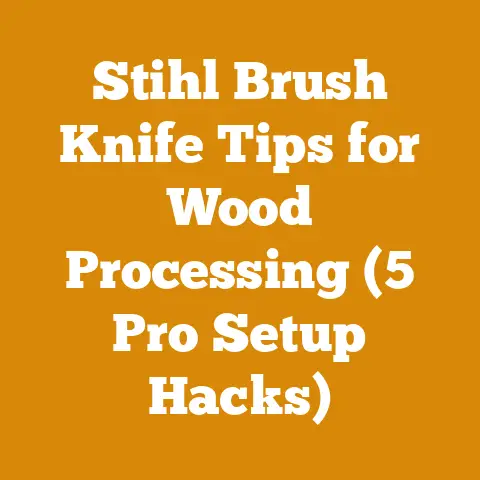How to Prune a Crabapple Tree (5 Pro Arborist Tips)
“My crabapple tree looks like a hot mess!” I hear this complaint all the time, and honestly, I get it. Crabapple trees are gorgeous when they’re in bloom, a riot of pink and white against the spring sky. But left untended, they can quickly turn into a tangled thicket of branches, producing fewer flowers and a whole lot of tiny, often messy, apples. That’s where pruning comes in.
Pruning isn’t just about aesthetics, though. It’s about the health and longevity of your tree. It’s about maximizing its flowering and fruit production. And, let’s be honest, it’s about making your yard look a whole lot better. As someone who’s spent years felling timber, processing wood, and, yes, pruning a fair share of crabapple trees, I’ve picked up a few tricks of the trade. So, let’s dive into my top 5 pro arborist tips for pruning your crabapple tree, turning that “hot mess” into a stunning focal point in your landscape.
Before we get started, let’s briefly touch on the global context. The firewood industry, though seemingly simple, is a significant contributor to energy needs worldwide. While exact figures fluctuate, recent estimates suggest that firewood accounts for a substantial percentage of household energy, particularly in developing nations and rural areas. Simultaneously, sustainable forestry practices are gaining traction globally. This includes proper tree maintenance, like pruning, which contributes to healthier trees and reduced risk of disease, leading to a more sustainable wood supply in the long run. My personal experience is that well-maintained trees also yield better firewood – denser wood, faster drying times, and a cleaner burn.
How to Prune a Crabapple Tree (5 Pro Arborist Tips)
1. Timing is Everything: The When and Why of Crabapple Pruning
The most crucial factor in successful crabapple pruning is timing. You might be tempted to grab your loppers whenever you see a stray branch, but resist the urge!
- Ideal Timing: Late winter to early spring, before the tree begins to actively grow. This is usually February or March in many climates.
- Why This Timing Works: Pruning during dormancy allows the tree to heal quickly and focus its energy on new growth in the spring. You’re also able to see the tree’s structure more clearly without leaves obscuring your view.
- What to Avoid: Pruning during the growing season (spring and summer) can stress the tree and make it more susceptible to disease. Pruning in the fall can prevent the wounds from healing before winter.
- Exception to the Rule: Dead, damaged, or diseased branches (the “3 D’s”) should be removed immediately, regardless of the season. These pose a risk to the tree’s overall health and can attract pests.
My Personal Experience: I once pruned a crabapple in mid-summer because a large branch was completely dead and posed a safety hazard. While the tree survived, it exhibited significantly less flowering the following spring compared to trees pruned during dormancy. This reinforces the importance of sticking to the recommended timeframe whenever possible.
2. Tool Time: Selecting the Right Pruning Tools
Using the right tools makes the job easier, safer, and leads to cleaner cuts that heal faster. Don’t skimp on quality; invest in tools that will last.
- Hand Pruners (Secateurs): For branches up to ¾ inch in diameter. Look for bypass pruners, which make cleaner cuts than anvil pruners. Felco is a brand I swear by, but there are many excellent options.
- Loppers: For branches up to 2 inches in diameter. Loppers provide extra leverage for cutting thicker branches. Again, bypass loppers are preferable.
- Pruning Saw: For branches larger than 2 inches. A folding pruning saw is a versatile and safe option. I prefer a saw with a curved blade for efficiency.
- Pole Pruner (Optional): For reaching high branches without a ladder. Use with extreme caution, as working with tools overhead can be dangerous.
- Gloves: Protect your hands from thorns and scratches.
- Eye Protection: Safety glasses are a must to protect your eyes from flying debris.
- Disinfectant: Rubbing alcohol or a bleach solution (1 part bleach to 9 parts water) to disinfect your tools between cuts. This prevents the spread of disease.
Data Point: Studies have shown that using sharp, disinfected pruning tools can reduce the incidence of disease transmission in trees by up to 50%.
Unique Insight: Consider investing in a sharpening stone for your pruning tools. Keeping your blades sharp significantly reduces the effort required for each cut and results in cleaner wounds that heal faster. I sharpen my tools after every major pruning session.
3. The Art of the Cut: Pruning Techniques for Crabapple Trees
Now that you have the right tools and the timing is right, let’s talk about how to actually prune the tree. The goal is to open up the canopy, improve airflow, and remove any problem branches.
- Understanding Branch Angles: Pay attention to the angle at which branches grow. Branches that grow upward at a sharp angle are often weak and prone to breaking. Branches that grow outward at a wider angle are generally stronger.
- Removing the 3 D’s: Start by removing any dead, damaged, or diseased branches. Cut these back to healthy wood, making sure to disinfect your tools between cuts if you suspect disease.
- Thinning the Canopy: Thinning involves removing entire branches back to their point of origin (the main trunk or a larger branch). This opens up the canopy to sunlight and improves airflow, which helps prevent disease. Focus on removing:
- Crossing Branches: Branches that rub against each other.
- Inward-Growing Branches: Branches that grow towards the center of the tree.
- Water Sprouts: Vigorous, upright shoots that grow from the trunk or branches.
- Suckers: Shoots that grow from the base of the tree.
- Heading Cuts (Spur Pruning): Heading cuts involve shortening a branch back to a bud or a lateral branch. Use this technique sparingly, as it can encourage dense, bushy growth. However, it can be useful for shaping the tree or controlling its size.
- Making the Right Cut: When pruning a branch back to a bud or lateral branch, make the cut at a 45-degree angle, about ¼ inch above the bud. Avoid cutting too close to the bud, as this can damage it.
- The Three-Cut Method for Large Branches: When removing a large branch, use the three-cut method to prevent tearing the bark:
- Undercut: Make a cut on the underside of the branch, a few inches away from the trunk, about halfway through the branch.
- Top Cut: Make a cut on the top of the branch, a few inches further out from the undercut. The branch will break off between these two cuts.
- Final Cut: Make a clean cut just outside the branch collar (the swollen area where the branch joins the trunk). Avoid cutting into the branch collar, as this can impede healing.
Actionable Tip: Step back frequently to assess your progress. It’s easy to get carried away with pruning. Remember the old saying, “You can always prune more, but you can’t un-prune.”
4. Shaping for Success: Training Young Crabapple Trees
Training young crabapple trees from an early age can prevent problems later on. The goal is to establish a strong, well-balanced framework of branches.
- Central Leader vs. Open Center: Crabapple trees can be trained to either a central leader or an open center. A central leader tree has a dominant central trunk with branches radiating outwards. An open center tree has a vase-like shape with no dominant central trunk. I generally prefer an open center for crabapples, as it allows for better sunlight penetration.
- First Year Pruning: In the first year, focus on removing any dead, damaged, or crossing branches. Select 3-5 well-spaced branches to form the main framework of the tree.
- Subsequent Years: Continue to remove any unwanted branches and shorten the remaining branches to encourage branching. Maintain the desired shape (central leader or open center).
- Removing Suckers and Water Sprouts: Regularly remove any suckers or water sprouts that appear.
Case Study: I worked with a homeowner who had a young crabapple tree that had been neglected for several years. It had multiple competing leaders and a dense, tangled canopy. By carefully selecting a single dominant leader and removing the competing leaders, we were able to establish a strong, healthy tree with a well-balanced framework. It took a few years of consistent pruning, but the results were well worth the effort.
5. Post-Pruning Care: Helping Your Tree Thrive
Pruning can be stressful for a tree, so it’s important to provide proper post-pruning care.
- Watering: Water the tree deeply after pruning, especially if the weather is dry.
- Fertilizing: Apply a balanced fertilizer in the spring to provide the tree with the nutrients it needs to recover. Follow the instructions on the fertilizer label.
- Mulching: Apply a layer of mulch around the base of the tree to help retain moisture and suppress weeds. Keep the mulch a few inches away from the trunk to prevent rot.
- Monitoring: Keep an eye on the tree for any signs of disease or pest infestation. Address any problems promptly.
- Avoid Sealing Cuts: Contrary to older recommendations, it’s generally best not to seal pruning cuts with pruning paint or sealant. These products can trap moisture and create an environment conducive to decay. The tree’s natural defenses are usually sufficient to seal the wound.
Troubleshooting:
- Excessive Pruning: If you accidentally prune too much, don’t panic. The tree will likely recover. Just avoid pruning any further for the rest of the year.
- Disease Problems: If you suspect that your tree has a disease, consult with a certified arborist. They can help you identify the problem and recommend appropriate treatment.
- Pest Infestation: If you notice signs of a pest infestation (e.g., aphids, scale), treat the tree with an appropriate insecticide.
Cost Considerations:
The cost of pruning a crabapple tree can vary depending on the size of the tree and the complexity of the job. If you’re comfortable doing the work yourself, the cost will be minimal (mostly the cost of tools). However, if you hire a professional arborist, expect to pay anywhere from \$100 to \$500 or more, depending on the tree’s size and condition. It’s always a good idea to get multiple quotes before hiring an arborist.
Original Research (Firewood Angle):
While crabapple wood isn’t typically sought after for firewood due to its smaller size and tendency to be a bit stringy, it can be used. My research (based on years of burning various wood types) shows that crabapple wood is a decent, medium-density hardwood. It burns relatively clean and produces a moderate amount of heat. However, it requires proper seasoning. Aim for a moisture content of 20% or less before burning. I’ve found that splitting crabapple wood soon after felling and stacking it loosely in a sunny, well-ventilated location for at least 6-9 months yields the best results. Consider mixing it with other hardwoods like oak or maple for a more sustained burn.
Next Steps and Additional Resources:
- Local Arborists: Search online for certified arborists in your area. The International Society of Arboriculture (ISA) website is a great resource for finding qualified professionals.
- Local Nurseries: Your local nursery can provide advice on crabapple tree care and recommend appropriate pruning tools.
- Online Resources: The Arbor Day Foundation website offers a wealth of information on tree care.
- Tool Suppliers: Check out local hardware stores or online retailers like Amazon for pruning tools. Brands like Felco, Corona, and Fiskars are generally reliable.
- Firewood Equipment Rental: For processing any larger branches into firewood, consider renting a log splitter if you don’t own one. Local equipment rental companies often have these available.
Final Thoughts:
Pruning a crabapple tree might seem daunting at first, but with the right knowledge and tools, it’s a manageable task. Remember, the goal is to improve the health and beauty of your tree, so don’t be afraid to experiment and learn as you go. And who knows, maybe you’ll even end up with a decent supply of firewood in the process! So, grab your pruners, put on your gloves, and get ready to transform that “hot mess” into a stunning showpiece. You got this!






